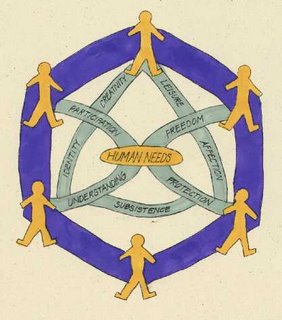It is human to speculate on the future of giants, elevating them to godly manifestations. It is human to take the giant’s workshop as an economic behemoth, divorced from reality. But with a burgeoning population of 1.065 billion, the world simply could not help but to note India’s ascendancy to an ‘economic superpower’ status. On the face it, statistics, for the most part, justified optimism. India’s GDP stands at a hefty US$600.6 billion (or US$3078 billion, adjusted for purchasing power parity) averaging a staggering 6.2% economic growth rate (1993-2003). At the end of the 2005-2006’s first quarter, India reports an 8.1% growth rate, not bad for an economy that stagnated at the ‘Hindu rate of growth’ – a 3.5% average annual growth rate – just decades ago. With apologies to Marx, the railroad analogy works well for the optimists describing ‘Shinning India’ – efficient, quick and zooming into the First World circles. But like its railways, India’s economic behemoth would crush hundreds of marginalised Indians along its track to global competitiveness.
To be sure, India has the tailwind advantages. Relative to the world average, it has a massive population, the second largest after China and a hefty 482.2 million labour force to deploy. Its state-of-the-art lycées, the likes of India Institute of Technology (IIT), yields the much needed engineers and entrepreneurs to run its technological parks and enterprises. Skilled labour is relatively cheap, prompting influx of multinationals, from General Electrics to American Express. Its Silicone Valley and call centres are much publicised, both as an Asian Wirtschaftswunder and as the economic behemoth it is, devouring American and European jobs.
With such glowing testimony, it is really no surprise that India’s economic engineers love to think of India as thrusting into the future through the wonders of Information Technology (I.T.) from its quaint slum-ridden legacies. India’s service sector constitutes 51% of India’s GDP Its wager on massive high end IT intensive industries – from call centres and transcription of medical records to Business Process Outsourcing (BPO) – are reaping the economy a healthy growth rates. Yet, behind the munificence of India’s Silicone Valley and the hubris of their legendary call centres lies the often neglected story of India’s displaced thousands.
In all fairness, an 8.1% growth is no less an Herculean effort – India now sets its aim for an annual 10% growth rate. But, economic growth rates are merely success stories of capital and profit not that of labour. The story of India should rest on its productive structures but rather on its people, their lives and their living standards. In no breadth of political philosophy was it ever to pursue economic functions for its own sake, above its social functions. India-optimists tend to confuse a vibrant economy as an ends in itself. From 11.6% unemployment to a gaping budget deficit, flaws within the economy are growing more evident by the day.
Back-office India
It is grave misnomer to describe India as ‘the world’s back-office’, at least not in the same sense or breadth of 19th century Britain as ‘the world’s workshop’. For all the talk of India’s ‘large-scale service-sector’ growth engines, ironically, its service sectors only account for a mere 23% of its labour force, of which only 770,000 (just under 0.165% of India’s labour force) employed in India’s prided IT-enabled service sector. Elsewhere, India’s staggering growth excludes a growing ‘unorganised service sector’ in with limited income mobility.
Here, the issue of income mobility is of little surprise. Its has a 61.3% adult literacy with secondary and tertiary education enrolment standing at 53% and 11%, respectively, all of which are below the world's average. Even technological saturation is unremarkable, indeed decrepit. At the most basic level of communication, the effect of technology is unremarkable. Just 4.6% of Indians are covered by telephone lines – hand phone subscription accounts for just 2.5% of its population. Indeed, with just 0.7 computers for every hundred people, a mere 0.4% internet penetration – lagging behind China (2%), Malaysia (11% and South Korea (58%) – and 0.02% Broadband penetration, the general backwardness of technological saturation is nothing short of a scandal for India's I.T. intensive sector.
Of computers and hand phones, Internet and palmtops, from India’s façade of modernity, it can be too easy to be fooled into imagining a socially liberal India. Particularly among the more rural parts, tradition still exhibits its pervasive influence in contemporary Indian society. Preference for males, due to matters of dowry and whatnots, rears its ugly head in illegal foeticide and in more extreme cases, infanticide. This somewhat account for the ‘male heavy’ gender ratio at 105 males to every 100 females, being worse in the more traditional villages and towns. Indeed, incidences of domestic violence are still high with some incidences of bridal murder in the event of dowry default and, perhaps more pathologically, ‘honour killing’. Sadly, like all other vicious circles, this can be self-perpetuating. The gap between male and female literacy (71.2% vs. 50.8%) would condemn women to a continuous line of immobility and discrimination.
Poor India
India’s consumer boom embraced at most 15% of India’s population. Poverty in India, on the other hand, grasps an estimated 25% of Indians. While official figures point to a declining poverty level, this can be deceptive. In his ‘Poverty and Inequality in India: Getting closer to the truth’, India economist, Abhijit Singh estimates 364 million or 35% living in absolute poverty. “Half of Indian children are clinically undernourished and almost 40% of all Indian adults suffer chronic energy deficiency”.
The story of poverty in India may indeed be that of unique circumstances. Where in most countries, the persistence of poverty is primarily a case of powerful elites requiring it for the sake of personal enrichment and as a means of gaining political clout, there is a more insidious motive in the Indian experience – to reinforce religious norm and the caste system. Such claims are often consistent with the worse incidences of poverty typically affecting the 150 million Dalit under-castes and 70 million tribal villagers.
The success of the Indian technocratic elite amidst a background of poverty is not so much a case of real fiscal mismanagement than the case of priorities gone wrong within multiple levels of the administration. For the large part of it, the State is largely at fault for India’s regional imbalances. Successions of the central administration by shades of neo-liberalism, from the Bharatiya Janata Party (BJP) to the Indian National Congress (INC), often betray the hopes of the marginalised Indians. Indeed in true Indian outsourcing fashion, tasks for poverty alleviation to rural development were often left to the market forces – or what is now dubbed ‘New Market’. Not surprisingly, market forces are poor servants to the impoverished. In the case of Mumbai, India’s largest city at a population 17.4 million, its largely unskilled workforce saw its textile mills giving way to ITES parks (IT-Enabled Services), throwing a large chunk of its workforce to unemployment and bare-subsistence desolation.
The case of Mumbai is just one among the many cases of the pervasive urban bias in India’s development. While, constituting the larger part of Indian employment (60%), the case of infrastructural and structural development in India’s agricultural is scarce. Such negligence can be particularly costly. For want of agricultural infrastructures – irrigations, transports to open markets and modern agricultural tools – literally wagers the livelihood of India’s largest employment sector, to the mercy of monsoons and middleperson. But these physical deficiencies are just one facet to the general inadequacy. Illiteracy, poor land laws – including Land Ceiling Acts – and lack of microfinance force farmers to fragmented land parcels while preventing benefits from scale economies. This is simply a case of priorities gone wrong; the state chasing after growth sector, ignoring the employment sector.
In tribal and Dalit populated parts, state negligence in providing basic infrastructures, from education to health facilities, can be particularly appalling, adding yet another hurdle towards income mobility. The state of Bihar, for one, has a per capita income of merely $94 against the national per capita of $560. Basic amenities, such as electricity, could be a luxury in the less developed parts of India. At times, even water access is scarce luxury – only 86% of the populace have access to improved water source. 80.4% of India faces severe water stress – consumption of water exceeding 40% of available water.
Given Prime Minister Manmohan Singh’s ‘no rollbacks of the New Market’, the shifting political balance – between the BJP to the INC – merely thrusts the helm of neo-liberalism into the hands of more effective ministers. At the micro level however, state ‘effectiveness’ is pretty much in the eyes of its beholders. Corruption is rife within its public office, stymieing public services from education to health. Transparency International (TI) ranks India 88th in terms of corruption (1 being the least corrupt, 158 being the least). Cases of police involved in serious crimes, such as kidnapping for ransom, are not uncommon. TI estimates US$4,833 billion loss from petty corruption alone.
The Indian Inflation
On one hand, gaps in the Indian social model may lie in the very monstrosity of its population. With a 1.066 billion strong population by 2003 and growing at an average 1.55% from 2000-2005, experts project a 1.563 billion population by 2050, surpassing even that of China’s. To be sure, a large population can be a boon in itself. In context, however, the case of India is far more dubious. India’s population boom and regional imbalance is a recipe for polarisation and desertion of rural landscapes. Already, population concentration in Mumbai (17.4 million), Delhi (14.1 million), Calcutta (13.8 million), Chennai (6.7 million), Bangalore (6.1 million), are doing little to the general welfare of its inhabitants, instead creating severe water stress, massive unemployment and welfare degradation – a case of too many people chasing too few resources.
Let them eat cake!
India has a neat piece of economic machinery going on, in any case. True, even in the strictest economic sense, its sophisticated machinery leaves still leaves much to be desired. It has a 22% debt service ratio, a whooping 11.6% unemployment and a foreign debt as large as 22% of its GDP to contend with, asides from wrestiling with issues of regional imbalances. Abysmal infrastructures – even in favoured port cities and urban centres – from congested ports to poor transportation do little to improve India’s competitive edge. Even the very factor underplaying India’s service sector ‘successes’ – a relative low wage – is working against itself; top graduates from India’s famous lycées are migrating abroad in droves, for want of greener pastures. Somehow, however, India’s economy is hobbling forward, imperfections and all. But in the case where the economy and society is really better off with the service sector boom, is it really too much for the privileged beneficiaries to share a bite of their cake with the marginalised millions?











